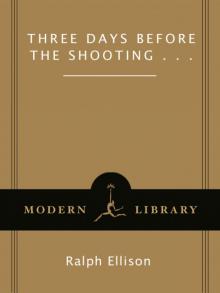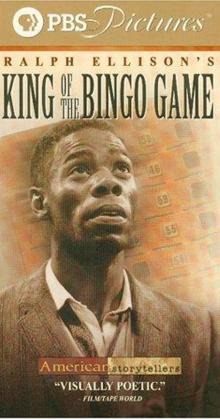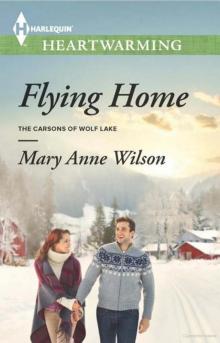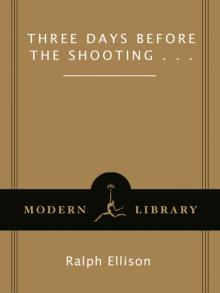- Home
- Ralph Ellison
Flying Home Page 3
Flying Home Read online
Page 3
In “Boy on a Train,” James, who has recently lost his father, rides with his mother and baby brother from Oklahoma City to McAlester, where a job as a domestic awaits his mother. (Ellison, too, took such a journey with his mother and younger brother, Herbert, and spent a year in McAlester.) “Boy on a Train” centers reality in the family; the protagonist, young James, sees the world in terms of its impact on his immediate kin. In the story James veers back and forth between the things of boyhood and expectations that he act like the man he is not. With his child’s eyes, he sees that white folks look differently at black people, wonders why, and, in the absence of an explanation, relies on wariness and alertness as camouflage against danger. His curiosity spurs him to learn the difference between how things looked (and were supposed to be) and how they are. He notices the difference between the world passing by the train window and conventional images of that world; the cow he sees looks “like a cow in the baby’s picture book, only there were no butterflies about her head.”
In the three early Buster-and-Riley stories, Ellison dramatizes his boyhood feeling—remembered in Shadow and Act—that “the fact that certain limitations had been imposed upon our freedom did not lessen our sense of obligation. Not only were we to prepare but we were to perform—not with mere competence but with an almost reckless verve, with, may we say (without evoking the quaint and questionable notion of negritude), Negro American style?” The two boys pursue what Ellison calls “the performance of many and diverse roles” in their longing to escape from the confining though protective nests of family, and fly freely in the larger world.
In “Mister Toussan,” Buster and Riley improvise a tall-tale version of Toussaint L’Ouverture’s historical exploits in the manner of call-and-response until the symbolic action of their language emboldens them to plot sneaking after some cherries that white man Rogan has declared off-limits. So it goes in “Afternoon” as the boys chafe at the deadend combination of boredom and conflicts with their elders in which race raises the ante. Riley’s father threatens to “smoke him,” in restoration of the old slave-borne punishment, and Buster resents his mother’s irritability all the more for knowing it came on “whenever something went wrong with her and the white folks.” In “That I Had the Wings,” when churchgoing elder Aunt Kate silences Riley’s signifying riffs on the Lord’s name and the Jim Crow code, the boys test their curiosity and restless aspiration against the limitations of nature. But when their scheme to teach some baby chicks to fly kills the chicks, Aunt Kate reappears like the angel of death, and Buster and Riley settle for the flight of words.
“A Coupla Scalped Indians” tells of a rite of passage in a narrative style that gives experience the quality of both immediacy and retrospection. When the boys hear the nasty mouth, signifying trumpet, as they walk toward the carnival from far off in the woods, Buster improvises words to go with what he hears in the music’s free flight:
“Saying,
‘So ya’ll don’t play ’em, hey?
So ya’ll won’t play ’em, hey?
Well pat your feet and clap your hands,
’Cause I’m going to play ’em to the promised land.
“Man, the white folks know what that fool is signifying on that horn they’d run him clear on out the world.”
But it’s the narrator who, recently “scalped” (circumcised) like Buster, blunders into knowledge in the tabooed shack of old Aunt Mackie for which others might run him “out the world.” Dazed, he emerges from his ambiguous, solitary manchild’s encounter with this ancient woman, mysterious and magical as the moon, whose naked body belies her wrinkled face with its telltale hairs and tenders him the promise and beauty of youth and the tidal pull of sexuality. “All is real,” he confides in wonder. Alone in the night, his sharpened senses touched by the shapes of nature, the narrator’s nuanced sensibility becomes suddenly attuned to feelings that open him to the mystery and possibility of life and the world.
“Hymie’s Bull” and its companion story, “I Did Not Learn Their Names,” are fictions of wariness, violence, and a surprising tenderness. Both stories refigure Ellison’s experiences hoboing the freights in the early thirties. “Hymie’s Bull” follows an unnamed young man on his own, on the road, going nowhere like others of his age; and in “I Did Not Learn Their Names,” another unnamed young man is hoboing his way somewhere—to college in Alabama, as Ellison did the summer of 1933. In each story the narration begins in the first-person plural, as if riding the rails gave the down-and-out a fraternal bond like that enjoyed by a ship’s crew. In “Hymie’s Bull” the we persists from beginning to end, punctuated by occasional shifts to you as Ellison’s narrator reaches out to those listening, and I when he bears witness to the bull’s unprovoked attack on Hymie and Hymie’s killing of the bull with a knife. In the eyes of Ellison’s narrator, Hymie is a matador, his suddenly unfurled knife a muleta. “Hymie’s Bull” becomes an escape story, too, for the young black narrator and his companions are due for a beating, jailing, or worse when they’re lined up in the Montgomery yards by two Alabama bulls snorting to avenge their dead fellow. The young hoboes are “happy as hell” riding on top of the freight car carrying them far away from the scene of the killing and the nearby Scottsboro frame-up of a couple of years before.
“I Did Not Learn Their Names” begins as if the narrator of “Hymie’s Bull,” more experienced now, tells another story. Here, we refers to the narrator and his buddy, and soon becomes I as he tells of Morrie, a white guy with an artificial leg, saving him from falling between two cars. Like “Hymie’s Bull,” “I Did Not Learn Their Names” moves in the syncopated rhythm of the freights its narrator rides, sometimes smoothly and swiftly, sometimes with the herky-jerky motion of cars bumping along, coupling and uncoupling in sudden stops, then returning to crawl or race toward a destination somewhere that is also nowhere. Like his successor Invisible Man, the narrator is personal, even intimate. “I was having a hard time trying not to hate in those days,” he confesses, and follows with a well-honed response to racial prejudice. “I still fought the bums—with Morrie’s help. But I had learned not to attack those who were not personally aggressive and who only expressed passively what they had been taught.” The young man vividly evokes the countryside from Colorado back through Kansas to Oklahoma, perhaps as Ellison remembered it from a trip to Denver with his high school band. At any rate, the old married couple the narrator meets in a boxcar are touching to each other and kind to him, almost to a fault. Keeping to the anonymity of “Hymie’s Bull,” the narrator does not identify himself. But he acknowledges the complexity of knowledge and language, revealing that he learned about Scottsboro while a prisoner in Decatur, Alabama, and that “I thought of the old couple often during those days I lay in jail, and I was sorry that I had not learned their names.” He had, of course, learned more than that. Once again there is Ellison’s (and his characters’) hunger for democratic equality; like Twain’s raft and Melville’s whaling ship, Ellison’s rails open up possibilities of fraternity even in the face of violence, danger, and racial hatred.
“A Hard Time Keeping Up,” “The Black Ball,” and “King of the Bingo Game” are stories of young black men testing the ground under their feet in the larger world, adapting to life as a game of chance in which the odds are long, the outcome at best in doubt and at worst fixed, even when you’ve won the jackpot. Like the trolley rail covered by snow in “A Hard Time Keeping Up,” the color line is always there. Visible or invisible, it’s palpable to the two dining-car waiters laying over in an unidentified town not that far from the Mason-Dixon Line and to John, the caretaker and handyman for an apartment building in “The Black Ball.” Like other early unpublished stories, “A Hard Time Keeping Up” is told by a narrator unidentified except for a fleeting reference to “Al” by his friend Joe, who seethes at the Jim Crow scheme of things, often on the verge of rage. The story gives the feel of two guys tramping through the snow to the best rooming house on the Negro side of t
own. They don’t look for trouble, but they expect it. Yet when what appears to be an ugly, sexually charged racial incident turns out to be a friendly wager between the underworld character, Ike, and Charlie, his black acquaintance from the sporting world, Joe and Al have the resiliency to laugh. In a reverberation of Hemingway, Ellison turns the utterly flat danger and despair of “The Killers” inside out.
Games and stacked decks are apt metaphors for Jim Crow rules in “The Black Ball,” perhaps the most subtly crafted and realized of the unpublished stories. John, the narrator, is taut with a father’s tenderness for his son. He is aware that no matter what he does, the boy will have—indeed, already has begun to have—his initiation into “the old ball game” of crooked ground rules. Set in the Southwest and, like other unpublished stories, typed on the back of the letterhead of the Montgomery County Republican Executive Committee, “The Black Ball” is nuanced by the narrator’s sensitivity to differences between the South and the Southwest. “Doesn’t he know we aren’t afraid to fight his kind out this way?” John wonders in a reflex response to the stereotype of the redneck before he learns that the man’s hands were fried with a gasoline torch because he stuck to his alibi for a black friend falsely accused of raping a white woman back in Alabama. Hearing the story and seeing the man’s hands, John feels his suspicion ebb. Here and elsewhere in the early stories, Ellison’s African-American characters show a persistent willingness to overcome their hostility to whites, suspend their disbelief, and perhaps join efforts toward brotherhood, in this case a union trying to organize black and white building-service workers. John’s memory of the white organizer’s burned hands, together with his boss’s threat to put him behind the black ball and his little boy’s wise-fool’s questions, nudges him toward the thought that “maybe there was a color other than white on the old ball.”
“King of the Bingo Game” is a third-person story in which a greenhorn migrant from the South to Harlem draws bingo and the right to take a turn at the wheel of fortune and the jackpot. Despite his urgent need for money to secure medical help for his wife, the act of spinning the wheel becomes his energy, his life, his God. The King of Bingo experiences that demonic power that Leon Forrest, in his “Luminosity from the Lower Frequencies,” associates with Ellison’s defiant imagination. He feels so liberated by the act of pressing the button that he cannot let go until it is forcibly taken from him by security cops, one of whom blackjacks him at the same moment he sees the wheel stop at double zero and the jackpot. Double zero is his fate; it’s “winner take nothing” except a beating behind the curtain, and doubtless again in jail or in the gutter before he’s set free. “King of the Bingo Game” anticipates the tithe paid to fluidity, violence, chaos, and the surreal throughout Invisible Man.
In its concentration on the riddle of identity, “In a Strange Country” also anticipates Invisible Man. In this story, “the answer to the complicated question of identity is a musical one,” Robert G. O’Meally has observed in The Craft of Ralph Ellison, and “music, here, is Ellison’s metaphor for democracy and love.” In his aching self-consciousness, the protagonist Parker realizes that to the Welshmen who befriended him after his fellow Yank servicemen blackened his eye, he is the true American. They recognize, as Ellison wrote many years later, that there is “something indisputably American about Negroes.” How painful it is for Parker to recognize and act on this perception. While the Welsh chorus belts out “The Star-Spangled Banner,” “as though to betray him he heard his own voice singing out like a suddenly amplified radio.” In the subconscious, the “strange country” stands less for Wales than for America, and like many Americans, Parker discovers his Americanness overseas. Attacked without provocation by the first white fellow countrymen he sees in Wales, Parker feels ambivalence toward America as both “the horrible foreboding country of dreams” and the country whose ideals he experienced in mixed jam sessions back home. “When we jam, sir, we’re Jamocrats,” he thinks to himself. Asked “HOW DOES IT FEEL TO BE FREE OF ILLUSION?” Invisible Man will reply: “Painful and empty.” And earlier, in “In a Strange Country,” Parker lays claims to an America “free of illusion.” His struggle for self-definition foreshadows Ellison’s desire, expressed in his 1981 Introduction to the thirtieth-anniversary edition of Invisible Man, “to create a narrator who could think as well as act” and whose “capacity for conscious self-assertion” was “basic to his blundering quest for freedom.” Like other narrators and characters in these stories, Parker anticipates Ellison’s creation, in Invisible Man, of “a blues-toned laugher at wounds who included himself in his indictment of the human condition,” and was therefore better able to see and embrace the world in its diversity.
Along with “A Party Down at the Square,” “Flying Home” frames the collection. The tale anticipates invisibility, the grandfather’s riddle, and the technique of solos and breaks with which Ellison took such flight in Invisible Man. In “Flying Home,” just when Ellison’s northern protagonist believes, with a nod to Joyce’s Stephen Dedalus, that he has learned to use his wiles to escape the limitations of race, language, and geography, circumstances force him to confront the strange “old country” of the South. A literary descendant of Icarus, Todd, one of the black eagles from the Negro air school at Tuskegee, flies too close to the sun and falls to earth in rural Alabama. There, unlike his mythological forebear, he is saved by Jefferson, whose folktales and actions enable Todd to recognize where he is and who he is, and to come back to life by following the old black peasant and his son out of a labyrinthine Alabama valley. Laughter, which Todd earlier associates with humiliation, erupts from deep inside him at the story’s climax, and taking advantage of the chaos, old Jefferson comes to the rescue and bears him away from danger.
In the 1981 Introduction to Invisible Man, Ellison recalls his pilot as a “man of two worlds,” who “felt himself to be misperceived in both, and thus was at ease in neither.” Looking ahead, he concludes that “I by no means was aware of his relationship to the invisible man, but clearly he possessed some of the symptoms.” And, Ellison might have added, he possessed a share of Invisible Man’s eventual, qualified, fraternal, democratic optimism. “A new current of communication [that] flowed between the man and boy and himself” enables Todd to transfigure a buzzard—one of the “jimcrows” he’d feared, identified with, and flown into on a training flight—into an emblem of flight and freedom. In the story’s last words he “saw the dark bird glide into the sun and glow like a bird of flaming gold,” perhaps a prophetic image, inspired by Lionel Hampton’s high-velocity signature jazz tune, “Flying Home,” of Ellison’s triumphant soaring in Invisible Man.
5.
Taken together, the short stories point to Ellison’s remarkably consistent vision of American identity over the fifty-five years of his writing life. In “The Black Ball” the little boy asks his father a question others before him have asked and those who have come after still ask from different sides of the color line. “Brown’s much nicer than white, isn’t it, Daddy?” “Some people think so,” his father concedes. “But American is better than both, son.” His response asserts Ellison’s belief in a common—not identical, but common—democratic identity. Simply put, this sentiment is Ellison’s creed. Like the narrator of this long-ago story, he pledges allegiance to America and the ideal for which it stands, aware of the distance that persists between the country’s reality and its principle. For Ellison, the idea of America is first cousin to the possibilities of fiction. He considered each a territory, as he inscribed in a friend’s book, “ever to be sought, ever to be missed, but always there.” Of his short stories this much we can say: They led Ralph Ellison into the territory of the novel—toward Invisible Man, with its freighted, frightening, fraternal “lower frequencies” of democracy, and beyond, to the terra incognita of his novel in progress.
—John F. Callahan
Washington, D.C.
November 1996
A Party Down at the Square<
br />
I don’t know what started it. A bunch of men came by my Uncle Ed’s place and said there was going to be a party down at the Square, and my uncle hollered for me to come on and I ran with them through the dark and rain and there we were at the Square. When we got there everybody was mad and quiet and standing around looking at the nigger. Some of the men had guns, and one man kept goosing the nigger in his pants with the barrel of a shotgun, saying he ought to pull the trigger, but he never did. It was right in front of the courthouse, and the old clock in the tower was striking twelve. The rain was falling cold and freezing as it fell. Everybody was cold, and the nigger kept wrapping his arms around himself trying to stop the shivers.
Then one of the boys pushed through the circle and snatched off the nigger’s shirt, and there he stood, with his black skin all shivering in the light from the fire, and looking at us with a scaired look on his face and putting his hands in his pants pockets. Folks started yelling to hurry up and kill the nigger. Somebody yelled: “Take your hands out of your pockets, nigger; we gonna have plenty heat in a minnit.” But the nigger didn’t hear him and kept his hands where they were.
I tell you the rain was cold. I had to stick my hands in my pockets they got so cold. The fire was pretty small, and they put some logs around the platform they had the nigger on and then threw on some gasoline, and you could see the flames light up the whole Square. It was late and the streetlights had been off for a long time. It was so bright that the bronze statue of the general standing there in the Square was like something alive. The shadows playing on his moldy green face made him seem to be smiling down at the nigger.

 Juneteenth
Juneteenth Invisible Man
Invisible Man Three Days Before the Shooting . . .
Three Days Before the Shooting . . . Flying Home and Other Stories
Flying Home and Other Stories King of the Bingo Game
King of the Bingo Game Flying Home
Flying Home Three Days Before the Shooting ...
Three Days Before the Shooting ...